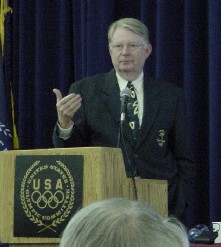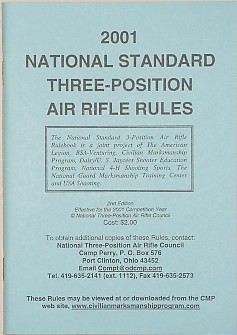
Gary Anderson
Director, CMP
| "We've Got to Go With What Works" |
 |
"The old, traditional junior program was based on smallbore rifle shooting. Smallbore rifle shooting is still prosperous as a junior activity…in areas of the country where new programs have started, they have almost exclusively been three-position air rifle. In many other places, three-position air rifle has been able to save junior shooting, and in fact turn it around so it is now growing
rapidly…" Gary Anderson Director, CMP |
| Friday afternoon of the coaches' conference was dedicated to three-position air rifle, which CMP Director Gary Anderson described as "very much the wave of the future,and,in many areas already, the wave of the present as far as junior programs are concerned." Anderson outlined eight basic components of starting a school rifle program, running from obtaining initial approval to competition and awards. He stated, as well, that were other factors key to a program's success. One, "we strongly recommend that programs start with three-position air rifle. Three-position air rifle makes programs possible where they simply would not be possible in most situations…in our experience, 99 out of a 100 programs starting now are three-position air rifle. Parental involvement was stressed. Anderson said, "I don't think it's a question of whether parents should be involved. It's a question of how you are going to get them involved." He added, "Every program that I have seen that…starts to go places is a program where there has beena successful effort to get the parents of these young people involved in this process." Anderson also emphasized the role of the coach, stating the CMP's commitment to coach training "is for real." In recruiting new coaches, he noted "the key is motivation"--while prior experience in marksmanship is a plus, "we've got to convince people you don't have to have previous experience to become a great shooting coach, a great shooting program leader." Anderson finished his presentation with an outline of the efforts being made on the national level to "bring together a unified set of rules" for three-position air rifle. Three-position air rifle competitions began in the 1960s with the Daisy/U.S. Jaycee Shooter Education Program. In the 1980s and 90s, the sport grew at a fast rate, until there were "many organizations, many rules, and huge numbers of participants." In 1999, the National Three-Position Air Rifle Council was formed. This council includes USA Shooting, the American Legion, the CMP, the Daisy/U.S. Jaycee Shooter Education Program, the National Guard Marksmanship Training Center, the National 4-H Shooting Sports, the Boy Scouts,and Navy, Army, and USMC JROTC. In January 2000,the council released the first national standard rules. In creating unified rules, the groups involved also created a "democratic process" for writing rules that included people in the field. Furthermore, they decided to offer the rule book to the public for free. In fact, it can be printed from the Internet at www.odcmp.com/forms/3posair2001.pdf. |
 www.odcmp.com/forms/3posair2001.pdf Components of a School Rifle Program
|